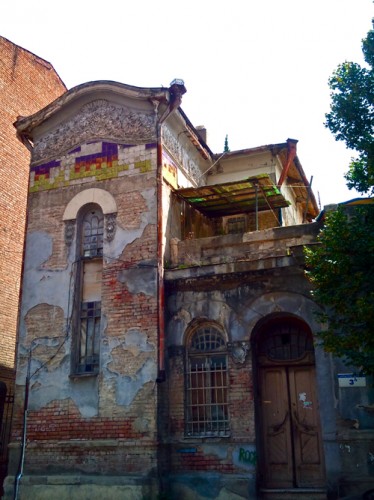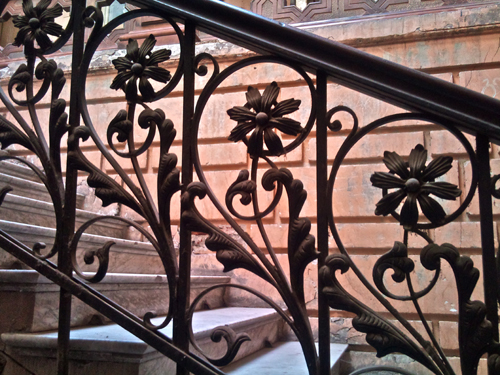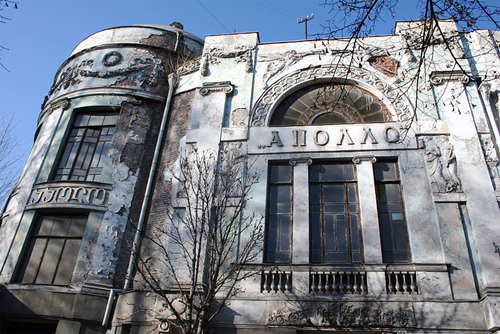 This article was originally published in Kunstpedia in August 2012 The curving lines of wrought iron and delicate motifs of Tbilisi’s art nouveau have been forgotten. The “Great Art Nouveau Cities of Europe” conjure up images of Paris, Barcelona, Nancy, Riga and Budapest, with iconic impressions left by Gaudi’s curves or even Paris’s Metropolitan entrances. Tbilisi on the other hand deserves its name on that list, and while the obscure South Caucasian capital is slowly gaining recognition for its Stil Modern architecture – it may be too late to save it. Georgia has always been a country of crossroads. Its location and history has turned it into a melting point of unique art and architecture that still burns bright today. However, as a former southern colony of the Russian Empire, Tbilisi is a city as European as Paris or Budapest, and in turn, has an architectural history that runs in parallel to the cities of Continental Europe. The decorative motifs of European art nouveau penetrated Russia and made its way down through the Caucasus into Tbilisi. The integration of modernist architectural design was simply a natural part of the city’s evolution, entering Georgia not only from the north, but also via the Black Sea. Art nouveau in Georgia flourished, and not only due to Tbilisi’s status as the cultural, political and administrative centre of Transcaucasia, but also from a general interest and disposition towards the style from local professionals and craftsmen. This resulted in numerous buildings springing up around the city that display rare and complex examples of the style. Georgian Stil Modern is eclectic, and perhaps even chaotic in parts. In the Georgian style, standard forms and repeated samples are rejected in favour of creative improvisation. While the movement’s innovation gave birth to Georgia’s modern architecture, it has become considered an “unimportant” part of the country’s art and architectural history. We have the imposed values of the Soviet Union to thank for that. This “bourgeois” art form was considered a “crime of ornamentation” and until the end of the Soviet Union these beautiful buildings were left to fall into disrepair and decay. After the modernist renaissance in Georgia, it wasn’t only the new houses that sprung up around the city that carried the aesthetic, but also cinemas, theatres, shops and even factories integrated the style. Renovations round Tbilisi opted to incorporate these flowing curves into their designs, and the various doors, staircases, balconies and façades with art nouveau details are a testament to its popularity. Tbilisi’s tragedy lies in the lack of protection and conservation of these monuments, many of which were damaged due to neglect, air and water pollution, and not to mention inadequate maintenance. A part of this conservation issue is both political and economical. Private houses predating the Bolshevik revolution became state-owned under the Soviet Union. The change of their function as private offices affected the buildings’ looks. Yet even with privatisation of these properties, many owners cannot afford the maintenance and rehabilitation of these buildings. Some of Tbilisi’s finest examples of art nouveau can still be seen if you take a walk round either the Mtatsminda neighbourhood or the streets surrounding Aghmashenebeli Avenue. This way, you’ll stumble upon beautiful, but overlooked examples. Their beauty still gazes out through flaking façades, but you have to stop to really look at them. Some of the buildings still retain their original interiors, sporting frescoes, gilded ironwork and small art nouveau details. Many of these buildings are hidden in Tbilisi’s back streets and to see some of the interiors may require some breaking and entering. The earliest examples of art nouveau in Tbilisi can be found just around Aghmashenebeli Avenue, such as number 4 Vartsikhe Street (renamed Rome street), which was built by architect Simon Kldiashvili. Since academic recognition of the art form arrived late in Georgia, the studies around art nouveau in the city’s architectural history are superficial. It is possible that there may be earlier examples of the style, but this residential house in Vartsikhe Street is perhaps the oldest existing example in the Stil Modern in Tbilisi – dating back to 1902. Its façade is decorated with omega shaped iron-wrought balconies and elaborated with detailed plasterwork. It serves as a unique example and impression of Georgian art nouveau. Close by on 36 Aghmashenebeli Avenue is a building dating back to 1903. It has original features on both its interior and exterior. I slipped through the back door of a second hand clothes store that offered forbidden entry into the hallway. Here you can see frescoes with scenes from Shota Rustaveli’s “Knight in Panther Skin” – a medieval Georgian poem that is a key to decoding Georgian culture. The old house on 3a Ia Karagereli Street dates back to 1903, and is an apartment by an unknown architect. It’s a beautiful example lined with coloured tiles and elegant motifs. The brickwork shows through the flaked exterior and this house is a certified example as to why the city needs to restore these buildings. Up in Mtatsminda, you can find other examples of fading grandeur. Number 12 Daniel Chonkadze Street, designed by architect M. Ohajanov, is a good example. The interior shows some beautiful, fragmented stained glass work that looks down onto an abandoned staircase. While the issue of the restoration of these buildings has been raised, this brings us to another problem – inappropriate construction and reshaping. Another concern, which is just as tragic as the disappearance of Tbilisi’s art nouveau monuments, are the examples of their poor renovation. In these cases original features and elements have disappeared under a layer of plaster and paint. Interiors are forgotten and modern inauthentic materials are used in the buildings’ reconstruction. The Apollo on Aghmashenebeli Avenue is an example of poor restoration. For years this endangered building was a knockdown waiting to happen, but even so, its recent restoration is not the saviour it should have been. Many of its original details and features have been erased rendering the Apollo almost unrecognisable, and easy to just bypass it without knowing it was once something special. Other such restorations include the TBC Bank on Marjanishvili Street and the National Bank on 3 Giorgi Leonidze Street. The fight to preserve Tbilisi’s art nouveau heritage continues, in 1997 the “Art Nouveau Preservation Group” and “The Open Society – Georgia” foundations were established, only a few years after the fall of the Soviet Union. Their aim is to raise awareness of the importance of these buildings as well as their protection. For the moment, damaged buildings that are in critical condition from this era are being destroyed in favour of replacing them with modern structures. Other buildings of the same time period are being subjected to careless and destructive restoration. These monuments are in desperate need of specialists who’ll care for the details and the décor with the respect they deserve. The art nouveau of Tbilisi is part of our global and cultural heritage. Even the World Monuments Fund has listed Georgia’s modernist buildings as some of the most important and endangered monuments in the world. One of Europe’s great art nouveau cities is on the brink of extinction, and the tragedy is no one knows it exists. I would like to give special thanks to Maia Mania for her knowledge and help in my research on Georgian art nouveau. References: 1. Nestan Tatarashvili, Art Nouveau in Tbilisi: Guidebook, map and routes (2008)
3 Comments
|
AuthorJennifer is a freelance writer specialising in art, travel & culture. This blog is a melange of her published articles and independent thoughts. Archives
July 2013
Categories
All
|



 RSS Feed
RSS Feed
